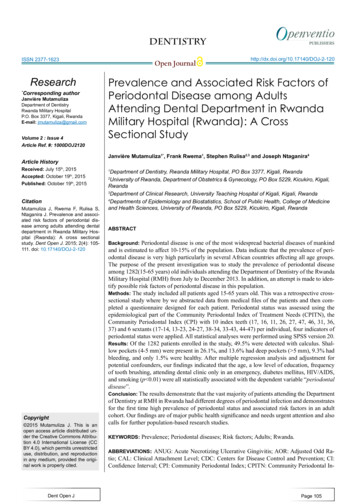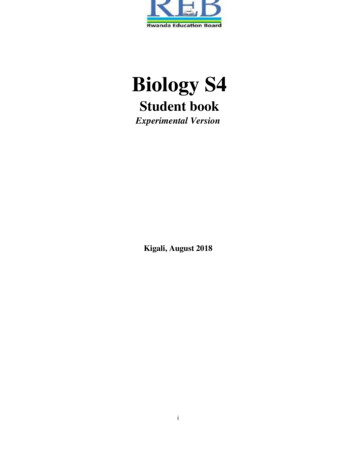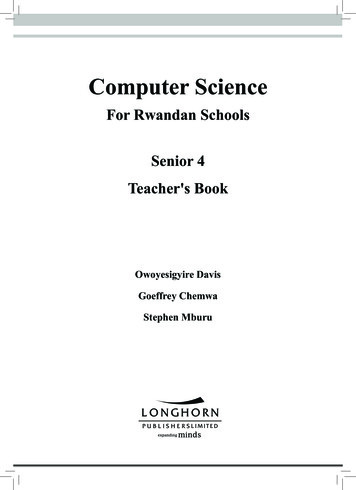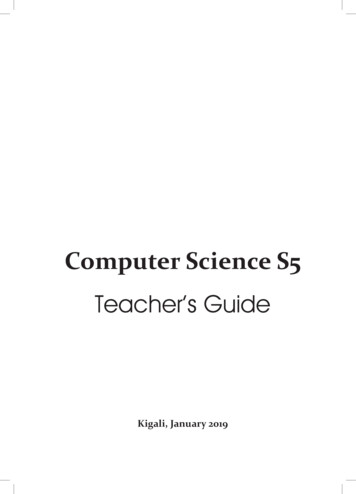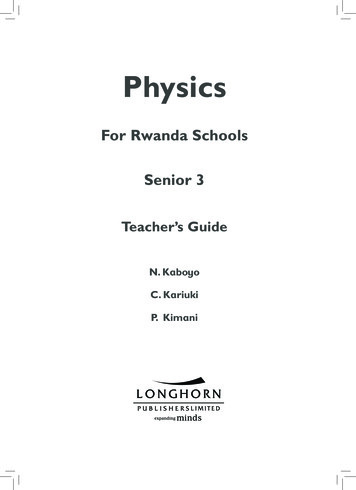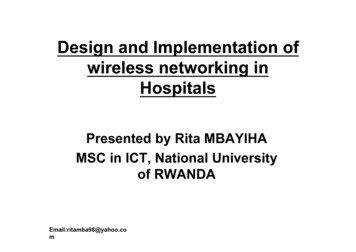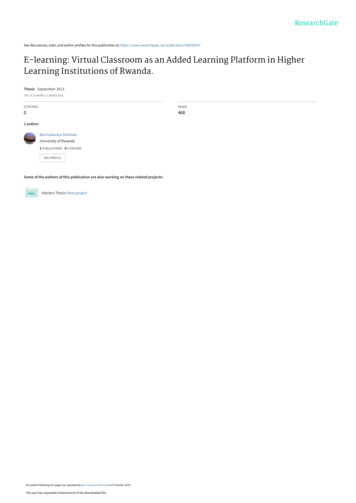
Transcription
See discussions, stats, and author profiles for this publication at: E-learning: Virtual Classroom as an Added Learning Platform in HigherLearning Institutions of Rwanda.Thesis · September 2013DOI: 10.13140/RG.2.2.30169.52325CITATIONSREADS04681 author:Ben Gakwaya RuhindaUniversity of Rwanda2 PUBLICATIONS 0 CITATIONSSEE PROFILESome of the authors of this publication are also working on these related projects:Masters Thesis View projectAll content following this page was uploaded by Ben Gakwaya Ruhinda on 07 October 2016.The user has requested enhancement of the downloaded file.
National university of RwandaFaculty of Applied SciencesMSc in ICT ProgramMASTER THESIS IN SOFTWARE ENGINEERINGResearch title: E-learning: Virtual Classroom as an Added Learning Platform inHigher Learning Institutions of Rwanda.Prepare by:Ben Ruhinda, bruhinda@nur.ac.rw, PG102000357Supervisor:September 2012Professor SUNG HAN PARKDean of Faculty of Applied ScienceNational University of Rwanda,shanpark@nur.ac.rw,
Thesis: E-learning Virtual Classrooms as an added learning platform in HLIs in RwandaDeclarationI hereby declare that this thesis work entitled, “E-learning: Virtual Classroom as an AddedLearning Platform in Higher Learning Institutions of Rwanda” is original has never beensubmitted to any university or other Institution of Higher Learning.This thesis work has been completed under the supervision of. Professor SUNG HAN PARKSignature Ben RUHINDABR. PG102000357ii / 5411 September 2013
Thesis: E-learning Virtual Classrooms as an added learning platform in HLIs in RwandaAcknowledgementI take this opportunity to acknowledge the National University of Rwanda (NUR) for provingme the opportunity to participate in MSC in ICT Program. I wish to thank also Sida Projectfor providing scholarship and funding for my research. I would like to pay my respectfulgratitude for my esteemed supervisor Professor SUNG HAN PARK for the keen interest andinvaluable guidance rendered to me under whose able guidance and motivation, this study hasbeen undertaken from its conception to its completion.I am grateful to him for being a constant source of encouragement and inspiration andwithout whom this journey would have been a figment of imagination.I am also very grateful to my wife Beza Elyane, family and all friends for their blessings andencouragement.I would also like to extend my gratitude to my classmates for giving valuable suggestionsduring the course of preparing this thesis time to time.I wish to thank also DPD staff for their encouragement and counselling.Above all, I bow my gratitude to the Almighty whose grace enabled me to complete thisthesis.BR. PG102000357iii / 5411 September 2013
Thesis: E-learning Virtual Classrooms as an added learning platform in HLIs in RwandaTable of ContentsDeclaration.iiAcknowledgement . iiiList of figures . vAcronyms and Abbreviations . viAbstract .viiChapter 1: Introduction . 11.1.Background . 11.2.Research questions . 21.3.Internet usage . 21.4.Aims and objectives; . 4Chapter 2: Review of virtual class room technologies . 52.1.Background information . 52.2.E-learning Models . 52.3.Virtual Classroom Architectures . 62.4.Building Blocks of Virtual Classrooms . 82.5.IMS Features that Enable Support for Virtual Classrooms . 112.6.Discussion . 12Chapter 3: Methodology. 143.1.Research design . 143.2.Tools for data collection . 143.3.Data recording . 15Chapter IV Results of Findings, analysis and discussions, . 164.1.The possibility of using virtual classrooms to supplement traditional classrooms in HLIs. . 164.2.Results of research interview with experts from MoH. . 164.3.Current eLearning status in HLIs in Rwanda . 254.4.The ICT Infrastructures in Rwanda . 36Chapter 5: Conclusion and Recommendations . 395.1. Conclusion . 395.2. Recommendation . 39References . 41Appendices .bBR. PG102000357iv / 5411 September 2013
Thesis: E-learning Virtual Classrooms as an added learning platform in HLIs in RwandaList of figuresFIGURE 1: DEVELOPED COUNTRIES VERSE DEVELOPING COUNTRIES INTERNET USAGE 2009 . 2FIGURE 2: INTERNET USERS IN THE WORLD -2011 . 3FIGURE 3: EVALUATION ANALYSIS OF USABILITY OF MOODLE PLATFORM USING SUMI METHOD . 22FIGURE 4: SCREEN SHOT OF MOH E-LEARNING PORTAL FRONT PAGE . 23FIGURE 5: SCREEN SHOT OF MOH PORTAL MENUS . 23FIGURE 6: SCREEN SHOT OF COMMUNICATION NOTICE. . 25FIGURE 7: GRADE ITEMS IN THE ELEARNING PLATFORM. . 25FIGURE 8: PERCENTAGE DISTRIBUTION OF ELEARNING VS FACE TO FACE. 26FIGURE 9: SCREEN SHOT OF LINK OF NUR ELEARNING PORTAL . 29FIGURE 10: SCREEN SHOT OF MANAGING ACTIVITIES ON NUR ELEARNING PLATFORM . 30FIGURE 11: ADMIN PORTAL SOURCE: NUR E-LEARNING PORTAL . 31FIGURE 12 SCREEN CAPTURE OF WIZIQ PLUG-IN LIVE CLASS . 32FIGURE 13: USER PERMISSION SCREEN PRINT SOURCE NUR E-LEARNING PORTAL . 32FIGURE 17: TELE CENTRES . 36FIGURE 18: MAP OF BROADBAND NETWORK COVERING ALL DISTRICTS. SOURCE: RDB/IT . 37FIGURE 19: ICT CENTRE PRESENTATION ON THE INCREMENT OF BANDWIDTH . 38FIGURE 20: ELECTRONIC SERVICES USAGE AT NUR (2009 – 2011) . 38BR. PG102000357v / 5411 September 2013
Thesis: E-learning Virtual Classrooms as an added learning platform in HLIs in RwandaAcronyms and SVLEVoDVoIPVoRWLANAccess Control ListAviation Industry Computer-Based Training CommitteeBroadband Systems CorporationCentre for instruction technologyCourse Management SystemData baseGovernment of RwandaGlobal Systems for MobileHigh DefinitionHigher Learning InstitutionsHypertext Transfer Protocol SecureInformation and Communication TechnologyInstitute of Electrical and Electronics EngineersInstant messageIP Multimedia Subsysteminternational private leased circuitInternet Protocol TelevisionKigali Institute of EducationKigali Institute of Science and TechnologyLearning Management SystemsManagement Information SystemMinistry of HealthModular, Object-Oriented, Dynamic, Learning EnvironmentMultiprotocol Label SwitchingNational Backbone NetworkNational Backbone NetworkNational Council of High EducationNational Institution of Statistics of RwandaNational University of RwandaOpen Distance and e-LearningResearch centreRwanda Education BoardRwanda Open UniversitySoftware as a ServiceSharable Content Object Reference ModelStudent Information SystemSystems, Man and CyberneticsSchool of Nursing and MidwifeSoftware Usability Measurement InventoryTeacher Training CollegesUniversal Mobile Telecommunications SystemVirtual Learning EnvironmentVideo on DemandVoice over IPVerification of RequirementWireless Local Area NetworkBR. PG102000357vi / 5411 September 2013
Thesis: E-learning Virtual Classrooms as an added learning platform in HLIs in RwandaAbstractSome of the challenges being face by the Ministry of Education (MoE) of Rwanda are theshortage of teachers, over-crowded classrooms and lack of teaching resources such astextbooks. Alternative teaching and learning platforms are needed to supplement traditionalclassroom teaching and learning. Virtual classrooms have been proven, in many countries, tooffer an alternative teaching and learning platform for students and teachers to engage on anacademic level. They have been a widely used in tertiary course delivery, such that someuniversities offer courses purely online.However, currently implementations required high bandwidth in order to support thecommunication tools that they offer, including voice and video conferencing, a sharedwhiteboard, instant messaging and file sharing. In many developing countries the high cost ofbroadband internet access is a major deterrent to the country’s broadband penetration rate.Users are opting to cheaper subscriptions plans at very slow dial –up speeds. This renderscurrent implementations nonviable due to their high bandwidth requirements. As a result,virtual classroom applications that require minimal bandwidth have become necessary as aviable supplement to traditional classroom teaching and learning. Minimizing the bandwidthrequirement of virtual classrooms is a key to its wide adoption by general users with lowbandwidth speeds.One of the aims of this research is to study the use of the Virtual classroom platform; thismethod of facilitating whiteboard updates will require some level of intelligence on the clientside to process the received text in order to update the whiteboard appropriately. The virtualclassroom framework that is proposed leverages on the security provided by IP multimediasubsystem network as well as its ability to support simultaneous mode of communications(video, audio, text) through SIP. The delivery platforms are able to offer Quality of Service(QoS), Quality of Experience (QoE) and security.As real-time application, the research will propose frameworks that adhere to real-timecommunication time constraints.Upon completion of the research, an evaluation platform will be recommended forimplemention and aiming to measure QoE of virtual classroom service.BR. PG102000357vii / 5411 September 2013
Thesis: E-learning Virtual Classrooms as an added learning platform in HLIs in RwandaChapter 1: Introduction1.1.BackgroundInformation technology has made a significant impact on global development; every countryhas a development plan to implement in regards to use of Information and CommunicationTechnology (ICT). Rwanda as a developing country is also encouraging the use of ICTservice delivery countrywide in order to optimise resource usage by enhancing the quality ofservice. Some of the challenges being faced by Ministry of Education of Rwanda are theshortage of teachers, overcrowded classrooms and lack of teaching resources such astextbooks. There is a need to adopt the use of educational processes that utilize informationand communications technologies to mediate asynchronous as well as synchronous learningand teaching activities; this solution, that supplements the traditional classroom teaching andlearning, is known as ‘e-learning’ or ‘the virtual classroom’. The use of virtual classroomshas been proven to offer an alternative teaching and learning platform for students andteachers to engage on an academic level. This has been widely used for tertiary coursedelivery, to the extent that some universities offer their courses purely online.The Government of Rwanda (GoR) strongly believes that ICT can enable Rwanda dominantthe key stages of industrialization. Thus GoR have integrated ICTs as a driving power forsocio-economic development and to fasten the speed of Rwanda’s transformation to aknowledge-based society National Information Communication Infrastructure Plan 3 (NICIIII Plan 2011 - 2015). The key objectives of National Information CommunicationInfrastructure (NICI) are to: transform Rwanda into an IT-literate nation; promote andencourage the deployment and utilization of ICTs within the society; improve the civil andpublic service efficiency; improve the information and communications infrastructure; makeRwanda a regional ICT hub; transform the educational system and enhance skillsdevelopment leveraging ICTs thereby developing a human resource base that adapts tochanging demands of the economy; and develop the legal, institutional and regulatoryframework and structures required to support ICT development.As else on the planet, Rwanda population is benefit to the wide spread of Internet and able toaccess virtual classrooms services. The growth of Internet is directly related to the increaseof information and communication technology as well as decrease of the cost. The capacityBR. PG1020003571 / 5411 September 2013
Thesis: E-learning Virtual Classrooms as an added learning platform in HLIs in Rwandaof ICT to support multimedia resource based learning and teaching is also relevantlygrowing.1.2.Research questionsThe following research questions will be focused;i.What uses of virtual classrooms with optimised bandwidth utilization are feasible asan option in Rwanda?ii.What are possibilities of using virtual classrooms to supplement traditionalclassrooms in Higher Learning Institutions (HLIs)?iii.1.3.Which is the most suitable framework for supporting services?Internet usageThe research will investigate the current state of ICT infrastructure in Rwanda. Rwanda andAfrica at large have lagged behind in the development and deployment of Internet access,resulting in limited access to high bandwidth and large scale internet infrastructure. Recentlythere is rapid change in the number of Internet users in Rwanda. The majority of the increaseis due to the business sector and higher education institutions. However, this number of thepopulation with Internet access is very low when compared to developed countries asdepicted in Figure 1.Internet users as percentage of population(a)(b)Figure 1: Developed countries verse developing countries internet usage 2009Figure 1(a) depicts the percentage of country’s populations that have access to internet or usethe internet. This percentage is plotted over several years. Figure 1(b) 4.4% of RwandanBR. PG1020003572 / 5411 September 2013
Thesis: E-learning Virtual Classrooms as an added learning platform in HLIs in Rwandapopulation in the year 2011 use internet. Notably, each countries plot shows an increase inthe number of people that have access to the internet. Figure 2 shows the World distributionby world Regions – 2011, much of the increase can be attributed to severalTelecommunication Companies and increased bandwidth availability.Figure 2: Internet users in the World -2011There is a need to provide less bandwidth demanding application for virtual classroomsuitable to the general user with their less Internet bandwidth. With these applicationsbeneficial (individuals, schools) will have access to virtual classroom services, which can beused to supplement traditional classroom.Advances in technology such as streaming both audio and video, however, mean that virtuallearning needs a stable and suitable infrastructure with optimum bandwidth. In underdeveloped countries such as Rwanda, the high cost of broadband internet access is a majordeterrent to the country’s broadband penetration rate. Users are opting for cheapersubscriptions plans at very slow dial-up internet speeds. This renders current implementationsnonviable due to their high bandwidth requirements to support the communication tools thatthey offer, including voice and video conferencing, a shared whiteboard, instant messagingand file sharing.There are a variety of e-learning platforms applicable for educational purpose; this researchwill focus on assessing and analyzing Rwandan educational infrastructure network and itsability to sustain the implementation of e-learning platform. This will also analysis differentplatforms and give some perspective for future implementations plans for the preferableplatform.BR. PG1020003573 / 5411 September 2013
Thesis: E-learning Virtual Classrooms as an added learning platform in HLIs in Rwanda1.4.Aims and objectives;This research will guide the researcher and policy makers in Education sector to choose anappropriate and suitable architecture of e-learning platform that is applicable to the educationnetwork of Rwanda. The following are research objectives;-To investigate the feasibility of sharing whiteboard and update it during a virtualclassroom session, with the aim of minimizing the bandwidth requirements of virtualclassroom applications.-To investigate the number of students and schools in Rwanda who have access tocomputers with internet access, to virtual classroom services. And to provide anoverview of the current state of Rwanda’s communication infrastructure and its abilityto support virtual classroom applications.-To evaluate the implementation of a virtual classroom application with support forvoice conferencing, shared whiteboard, Instantaneous Message (IM), presence andfile sharing, that maintains real-time communication.BR. PG1020003574 / 5411 September 2013
Thesis: E-learning Virtual Classrooms as an added learning platform in HLIs in RwandaChapter 2: Review of virtual class room technologies2.1.Background informationThe emergence of the World Wide Web (WWW) has paved the way for a new system ofacademic learning. Traditional methods of academic learning which involve people being in asingle venue at a specific time for learning to occur is fast becoming unsuited to the lifestyleof many people today.The Internet opens doors for new academic learning paradigms. Online classes have becomemore popular over the last decade. E-Learning grew by 86% between 2006 and 2008 inregard to the total number of courses delivered. Virtual Classrooms in the same light grew by33% within that same period [1]. These percentages are a clear indication that more studentsare taking-up online courses as opposed to traditional classroom classes. The popularity ofonline classes has grown so much that some university programs are purely online based,offering all their courses over the Internet [2].In another research based on the pilot evaluation of Learning Activity Management System(LAMS) [3], 80% of students preferred to discuss their ideas in a virtual environment, whileonly 15% preferred a physical classroom.Based on the scale of accepted theory of Educational psychologist by William Glasser, statesthat we learn by; 10% of what we read, 20% of what we hear, 30% of what we see, 50% ofwhat we see & hear, 70% of what we discuss with others, 80% of what we experience and95% of what we teach someone else. E-Learning that includes student interactivity andpersonal involvement in the learning process has the potential to successfully deliver thehighest student learning possible (just short of them teaching someone else). Thus, eLearningcan be highly effective, if designed properly [4]. This further highlights the paradigm shift instudent experience – student interaction and learning in general.2.2.E-learning ModelsThe intentional use of ICT in education support what is referred to as e-learning; itencompasses learning at all levels, both formal and informal, from simple tutoring to thedelivery of whole courses. ICT in e learning refers to a diverse set of tools and resources usedto communicate, create, store and manage information. These tools and resources includeBR. PG1020003575 / 5411 September 2013
Thesis: E-learning Virtual Classrooms as an added learning platform in HLIs in Rwandacomputers and the internet, telephones, television and radio. Online learning was madepossible by integrating ICT into education.ICT enables students to take courses online. As an internet based academic learning platform,students taking online courses require computers with internet access in order to accesscourse content, assignments and tests. E-learning course deliveries are usually achievedthrough two design approaches; asynchronous (non-real-time) and synchronous (real-time)each with its own pros and cons. The two approaches are briefly presented:-Asynchronous (Non-real-time) ModelOnline e-learning is referred to as asynchronous learning. Students work independentlythrough a set of course objectives and correspondence among themselves as well as with theinstructor happens via email and discussion boards. The students are often given a time framein which to perform given tasks.-Synchronous (Real-time) ModelThe synchronous approach often involves the use of a virtual classroom to aid coursedelivery. With this model, students engage with the instructor on a real-time basis.Communication between student and instructor communication occurs through audio, video,instant messaging and usually a shared whiteboard interface. Virtual classrooms grew morepopular among students, due to their real-time nature, as it gave them the opportunity toaddress issues concerning course materials during the lesson delivery.2.3.Virtual Classroom ArchitecturesThe functional needs of a virtual classroom may differ depending on what it is used for.Virtual classrooms may be used to teach or used to discuss business related matters fromvarious parties involved (business meetings, brainstorming sessions). Two main virtualclassroom architectures exist to cater for these two scenarios. These are discussed below.2.3.1 Role-based ArchitectureThe role based architecture is implemented in “a multiple distance learning System on theinternet as described in the conference proceedings of IEEE SMC’99” [5], [6] and in otherBR. PG1020003576 / 5411 September 2013
Thesis: E-learning Virtual Classrooms as an added learning platform in HLIs in Rwandaonline web based services [7]. In this case the virtual classroom is used for teaching a groupof individuals. In this architecture each participant is assigned a specific role. The differentroles include:-Teacher (Instructor) act as a facilitator of a classroom session. They also developcourseware to be taught during sessions.-Class expert helps students solve technical problems (such as no sound, microphoneproblems, etc) that they may encounter during a session.-An administrator is responsible for maintaining all aspects of the distance learningand all aspects of the learning system such as user access rights and studentregistrations.-The team leader is a person in charge of a group when students are divided intogroups. The team leader may also be in charge of the whole class when the teachers/instructors are absent.-Students are the people who access the course content. That is, the people who aretaught by teachers/ instructors.Each of the roles has a set of responsibilities and privileges. For example, in some literatures,the teacher has control over the microphone and the whiteboard facilities. Having access tothe microphone gives the teachers the privilege to speak while the rest of the class listens.The teacher also has the ability to grant participants access to these facilities. A role policy isused to assign roles to participants. The implementation of the role policy differs and issubject to the designer’s preference.Some authors allowed students to switch between roles, giving them different privileges. Thisis particularly useful during break away sessions, where different students can take up theteam leader role.2.3.2 Collaborative ArchitectureAnother approach to virtual classroom architectures is based on the notion of collaboration.Collaboration is at the forefront of a variety of classroom techniques that are currently beingadvocated. Collaboration is based on the notion that students master certain subjects betterBR. PG1020003577 / 5411 September 2013
Thesis: E-learning Virtual Classrooms as an added learning platform in HLIs in Rwandawhen they work in groups with equal “rights“ rather than as individuals. Furthermore, groupwork is beneficial to problem solving.Collaborative learning is a well-established group work method that provides a usefulalternative to teacher-fronted classes. Collaborative learning has other benefits in the contextof teaching and learning, including developing the students’ social interaction skills,communication skills and much more due to its “all participants are equal” policy.Traditional classrooms foster group work for certain activities and as a result virtualclassroom applications need to adhere to this requirement. Commonly found in virtualclassroom course delivery sessions is what is known as “break-away” teams. During asession, a facilitator may group certain participants together to form smaller groups. Thesegroups are given a subject to discuss or a problem to solve and after the allocated time haselapsed, the assigned team leader reports back to the larger class. These “break-away” teamsresemble traditional classroom setting where a teacher divides the students into groups towork through a certain problem.This architecture does not define any roles and all participants are considered equal. Thiskind of virtual classroom architecture will be better suited for business meetings or businessbrainstorming sessions where all parties are given the same privileges.2.4.Building Blocks of Virtual ClassroomsRecent trends in technology points towards the integration of services into single devices.Just over two decades ago one had a television set, a video recorder and a hi-fi system forentertainment (video and audio) but today, a single computer will suffice. Printers now domore than just print papers, but perform other functions like scanning, photocopying andemailing. It is clear that people want single devices that do more for them than havingmultiple devices performing different but related functionalities. Cellular phones are thewinners in this regard. These communication tools provide support for both collaborativeand individualized communication. The following subsections discuss the different buildingblocks of virtual classrooms.BR. PG1020003578 / 5411 September 2013
Thesis: E-learning Virtual Classrooms as an added learning platform in HLIs in Rwanda2.4.1 WhiteboardA whiteboard is mostly seen as the main feature of a virtual classroom and sometimesreferred to as the “chalkboard with an electronic edge”. The idea behind it is to mimictraditional blackboard functionality as best as possible. The physical board is represented by awhite rectangular drawing space. The chalk is replaced by either the mouse or an externalelectronic writing pen. These whiteboards are equipped with tools that allow users to drawshapes (triangles, rectangles, circles, etc), text and free hand drawing. Whiteboards arefurther equipped with colour selection menus and a variety of te
Thesis: E-learning Virtual Classrooms as an added learning platform in HLIs in Rwanda BR. PG102000357 ii / 54 11 September 2013 Declaration I hereby declare that this thesis work entitled, "E-learning: Virtual Classroom as an Added Learning Platform in Higher Learning Institutions of Rwanda" is original has never been submitted to any university or other Institution of Higher Learning.


